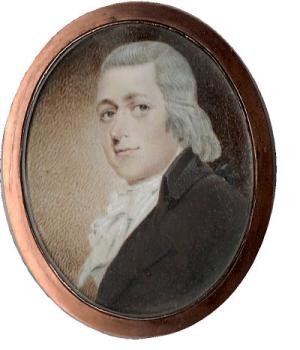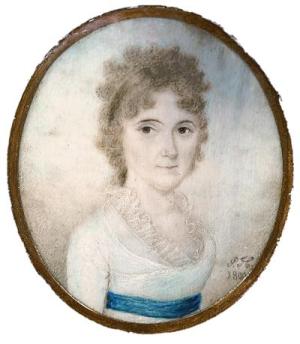John Brown (b. 1757- d. 1837)
The Hon. John Brown was born in 1757 near Staunton, Virginia. He grew up there, the second of seven siblings, in a close-knit Presbyterian household where education and religion were paramount. These are values John would carry with him his entire life as a lawyer, congressman, and U.S. Senator.
In 1774 John began his education first with Rev. James Wadell then at the College of New Jersey, better known as Princeton today, but he would only be there a short time before joining the Rockbridge County Militia[1] to serve auxiliary support to Lafayette's forces in the American Revolution. John would continue his education in 1778 at William and Mary College in Williamsburg, VA., where he would study Law. During his time at school, John would become acquainted with influential Americans who would become friends and mentors. Most notably future President Thomas Jefferson, who instructed John in the Law after he graduated. The two would remain friends and correspond throughout their lives[2].

What is Kentucky today was once part of Virginia. It was a place where folks could make a name for themselves acquiring wealth along the way, including up and coming lawyers. After the death of his uncle and patron, William Preston in 1783, John moved to Kentucky seeing the need for his services and a great opportunity to improve his station[3]. Just months after he arrived, he became a representative of the Kentucky County in the Virginia legislature, beginning his political career[4].
After years of debate, petitioning and negotiation, John Brown and other politicians developed a state constitution and became the Commonwealth of Kentucky in 1792[5]. Shortly after attaining statehood, John was elected to the U.S. Senate and served for three terms as Kentucky’s first senator[6]. While growing his political career and fighting for Kentucky’s statehood, John and his brother James created a thriving law practice that served a myriad of notable Kentuckians[7].
At the age of 42 John married 26-year-old Margaretta Mason in 1799. For much of their early marriage, John was away serving in Congress. Once he returned to Liberty Hall for good, he continued his law practice and became invested in shaping Frankfort into a proper capital city. The Browns, both children of Presbyterian ministers, helped to establish Frankfort’s first Presbyterian Church in 1816[8]. It still stands today and is catacorner to Liberty Hall. John would also be appointed to the board of the Bank of Kentucky[9], help found the Frankfort Water Company[10], and serve as a commissioner to build the State House[11].
In 1837, Margaretta and John took a trip east visiting friends and family they hadn’t seen in years, but upon their return to Kentucky John became ill and died on August 29th[12].
Margaretta Mason Brown (b. 1772- d. 1838)
Margaretta Mason was born and raised in New York City and was the youngest of three siblings. Like John, she grew up in a Presbyterian home that valued religion and education-- even for women. She attended multiple girls’ schools in New York, but most notably the Isabella Graham School, there she would find a love for literature, French, and writing of which she would be a lifelong student[13].

Margaretta and John married in New York on February 21, 1799, after being acquainted for years[14]. That same year their first son Mason would be born in Philadelphia. The two would live at Conrad and McMunn’s Boarding House in Washington after their marriage before moving into an unfinished Liberty Hall in 1801. Margaretta, a new mother and pregnant again, moved to Kentucky, ran the household, and looked after the children almost entirely by herself while John served in Congress.
In 1801 the Brown’s second son, Orlando was born. Margaretta and John would have five children but two (both named Alfred) died in infancy and a third, Euphemia, died in 1814 at age seven from malaria. The deaths of her children, particularly Euphemia’s, deeply impacted her and she grieved for them for the rest of her life[15].
In between raising children and managing a household, Margaretta was a voracious reader of various genres and subjects though she particularly enjoyed poetry and was a poet herself. Some books from her reading list includes early feminist texts like Mary Wollstonecraft's A Vindication on the Rights of Woman, gothic novels like Walpole’s Castle of Otranto, Classical epics like The Odyssey and The Aeneid, various scientific texts, religious writings, and sermons[16]. In her correspondence with family and friends, Margaretta expressed strong intellectual, political, and religious opinions as well as a knowledge of current events.
Her dedication to learning turned into a passion for education and in 1810 she founded the Sabbath School for boys and nine years later a school for girls. She served as the school’s first superintendent and treasurer. In the early days of the Sabbath School classes met in Liberty Hall’s gardens and were taught by Margaretta and her friend and neighbor, Elizabeth Love[17]. Her days of teaching inspired her to write a dictionary of religious terms for her students called Food for Lambs in 1824[18].
Margaretta died suddenly May 28, 1838, from a stroke less than a year after John[19]. She was remembered fondly by her friends and the community.
References
[1] Steven Walker, Kentucky’s First Senator: The Life and Times of John Brown, 1757-1837, 100-105; Orlando Brown, “Obituary, Senator John Brown,” Commonwealth, September 27, 1837
[2] Walker, Kentucky’s First Senator, 118,127,134-135,152-153
[3] ibid, 159-160
[4] ibid. 168
[5] 1 Annals of Congress, 411-12 (1790); Walker, Kentucky’s First Senator, 548-551
[6] John Brown to Henry Lee Governor of Virginia, September 29,1792, New York Public Library
[7] Fee Book 1785-92, Liberty Hall Collections
[8] Morgan Lockhard, “I Never Saw A Death More Lamented Than Hers By All Classes”: Margaretta Mason Brown as a Case Study in Republican Motherhood in Kentucky, 2016
[9] Collins and Collins, Collins’ Historical Sketches of Kentucky, vol. 2
[10] Jillson, Early Frankfort, 129.
[11] Winfrey P. Blackburn Jr. And R. Scott Gill. Gideon Shryock: His Life and Architecture 1802-1880 (Canada: Butler Books, 2021)
[12] “Obituary, Senator John Brown,” Commonwealth, September 27, 1837.
[13] Eliza Quincy, Memoir of the Life of Eliza S. M. Quincy, 1861; Boarding School Flyer, Folder B-5, UK
[14] Kentucky Gazette April 4, 1799
[15] Ed. Cecil D. Eby Jr., Alfred Beckley’s Recollections of Kentucky, Register of the Kentucky Historical Society
[16] Margaretta Brown, Reading List, Colonel John Brown and Major General Preston Brown Papers, Yale University
[17] Morgan Lockhard, “I Never Saw A Death More Lamented Than Hers By All Classes”: Margaretta Mason Brown as a Case Study in Republican Motherhood in Kentucky, 2016
[18] Helen Deiss Irvin, Women in Kentucky, p. 40
[19] Kentucky Gazette, June 7, 1838
